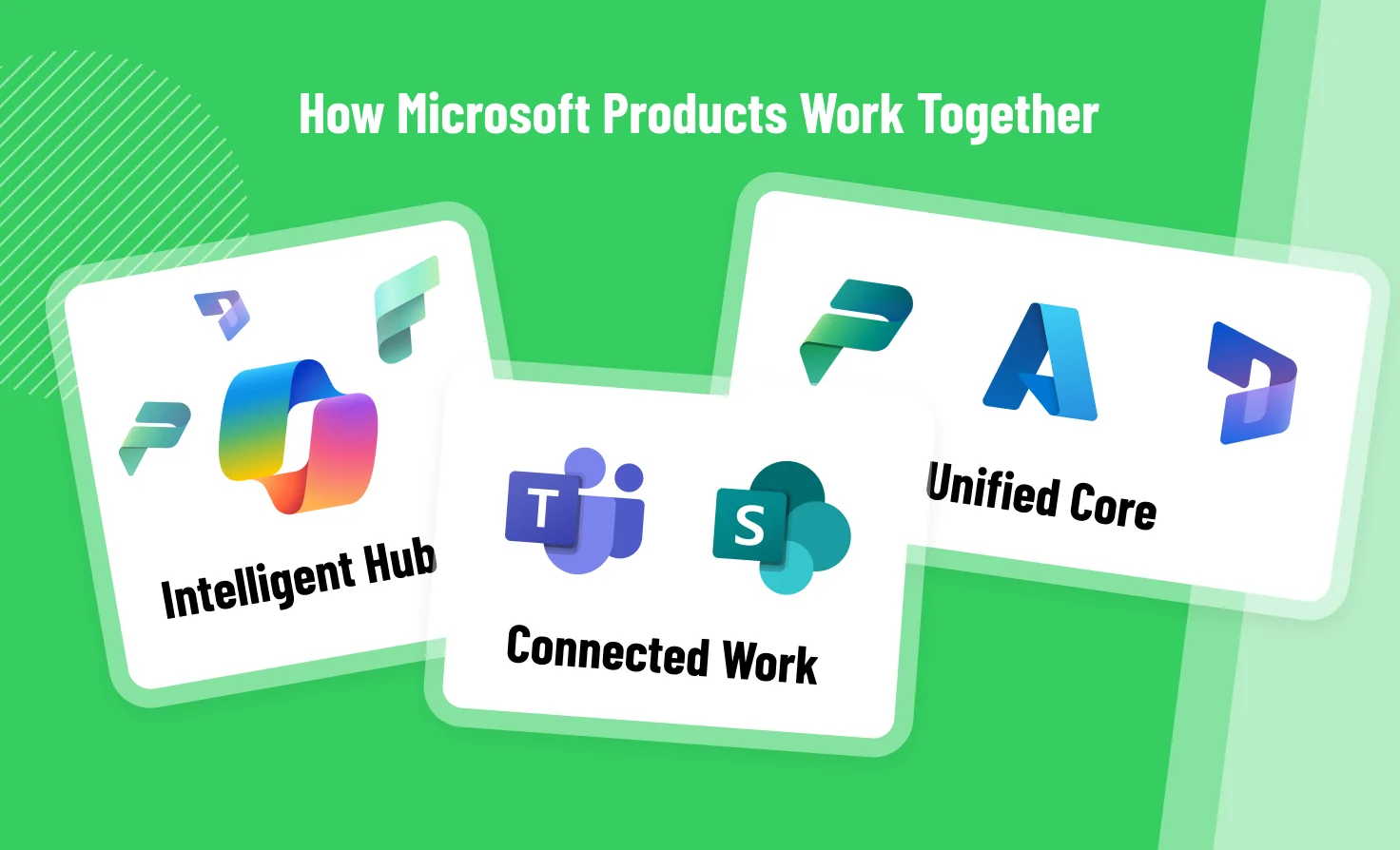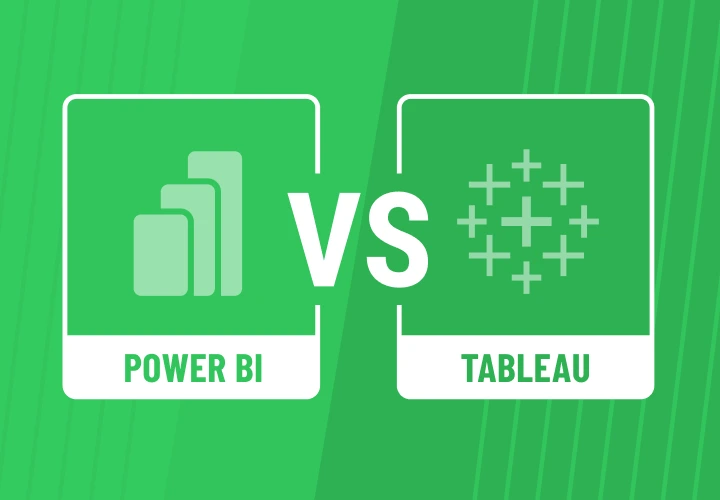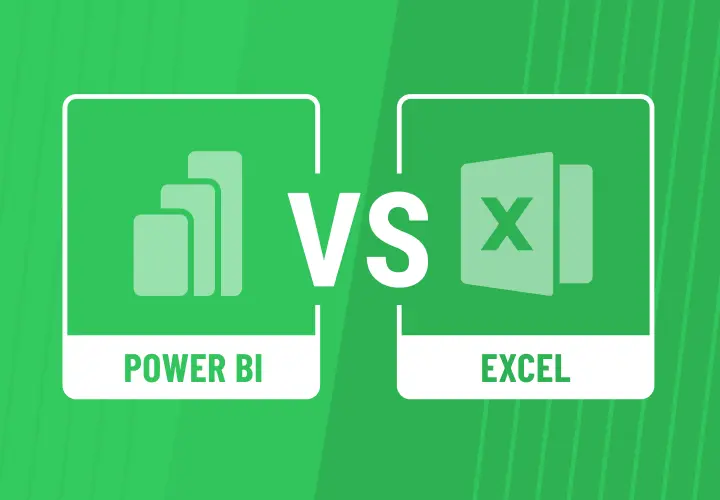The Ultimate Guide to the Microsoft Ecosystem
In the digital-first era, enterprises are becoming increasingly aware that fragmented IT environments hinder their progress. Different systems that don’t communicate, siloed data, and a lack of security coherence all become barriers to growth. To overcome these challenges, leading organizations are moving toward integrated technology ecosystems — comprehensive environments where applications, cloud infrastructure, and data services operate as one.
The Microsoft ecosystem stands at the forefront of this movement. It is a robust framework where every element is designed to connect seamlessly, delivering uninterrupted performance, enterprise-level security, and global scalability. Microsoft 365 boosts everyday productivity, Azure provides an opportunity to leverage advanced AI models, and Dynamics 365 offers access to intelligent business applications. This ecosystem encompasses every corner of the modern digital enterprise.
Core Components of the Microsoft Ecosystem
At the heart of the Microsoft ecosystem lies a set of tightly interconnected platforms designed to cover every layer of digital business operations. What makes the ecosystem truly powerful is the variety of tools together with the way these tools are engineered to seamlessly integrate, ensuring scalability, security, and continuous innovation. Below, we’ll break down the core components and their sub-solutions, showing how they together create a holistic foundation for digital transformation.
Microsoft Power Platform
The Microsoft Power Platform is often described as the “innovation layer” of the ecosystem. It empowers organizations to move beyond traditional software constraints, offering low-code and no-code solutions that enable both business users and developers to build, automate, and analyze with agility.
- Power Apps provides the tools to design custom applications tailored to unique business needs. Instead of relying on off-the-shelf software, organizations can create intuitive apps that bridge workflow gaps, connect data, and simplify user interactions, while significantly reducing development time.
- Power Automate is the engine of workflow automation. By linking systems and eliminating repetitive manual tasks, it accelerates processes, reduces errors, and frees employees to focus on higher-value work. Whether it’s document approvals, data synchronization, or cross-platform integration, Power Automate enables businesses to scale efficiency.
- Power BI turns raw data into actionable insights. It connects to multiple data sources and offers interactive dashboards, equipping decision-makers with real-time intelligence. Organizations no longer need to guess; they can track KPIs, forecast trends, and make decisions grounded in evidence.
- Power Pages opens up opportunities for building secure, professional-grade websites with little technical overhead. It is particularly powerful for customer or partner portals where business logic from Dataverse or Dynamics 365 can be exposed directly to external stakeholders.
- Copilot Studio brings AI into the low-code environment. With AI-assisted app design and natural language prompts, even non-technical users can shape functional solutions, creating a democratized space for innovation.
- Dataverse acts as the unified data backbone of the Power Platform. It provides a scalable, secure, and standardized data storage layer that enables all applications within the ecosystem to share and leverage consistent, reliable information.
Together, these components enable organizations to stay ahead of change and proactively shape their digital future.
Microsoft Dynamics 365
Dynamics 365 is the business applications layer of the Microsoft ecosystem. It provides integrated CRM and ERP solutions, connecting every function from sales and marketing to finance and operations in a single, data-driven suite. Unlike fragmented legacy systems, Dynamics 365 brings real-time visibility across the enterprise.
- Dynamics 365 Sales supports revenue growth by enabling smarter customer engagement, guided selling, and predictive forecasting.
- Dynamics 365 Finance ensures financial transparency and control, helping enterprises optimize cash flow, automate billing, and comply with global regulations.
- Dynamics 365 Customer Service elevates customer interactions with intelligent case management, omnichannel support, and AI-driven recommendations.
- Dynamics 365 Field Service optimizes field operations by connecting technicians, customers, and back-office staff, ensuring timely resolutions and efficient resource allocation.
- Dynamics 365 Marketing empowers marketers to design data-driven campaigns, automate outreach, and measure impact across multiple channels.
- Dynamics 365 Customer Insights provides a 360-degree view of customers, combining behavioral, transactional, and demographic data to deliver highly personalized experiences.
- Dynamics 365 Project Operations streamlines project management, resource planning, and budget oversight, ensuring projects are delivered on time and within scope.
- Dynamics 365 Business Central is an all-in-one solution for small and mid-sized companies, offering ERP functionalities to manage finances, sales, supply chain, and operations seamlessly.
This suite is designed not just as isolated apps but as an interconnected hub that integrates tightly with Power Platform and Azure, enabling true data-driven business transformation.
Azure Cloud Platform
Azure is the foundation on which much of the Microsoft ecosystem runs. It provides more than 200 products and cloud services spanning infrastructure, AI, data analytics, and hybrid environments. With Azure, organizations can migrate legacy workloads, modernize applications, and leverage elastic scalability while maintaining enterprise-grade security.
Key areas where Azure shines include:
- Cloud Infrastructure that supports everything from virtual machines to serverless computing.
- AI and Machine Learning Services that enable predictive analytics, natural language processing, and image recognition at scale.
- Data Analytics and Storage solutions, such as Azure Synapse Analytics and Azure Data Lake, enable organizations to unify and process massive amounts of structured and unstructured data.
- Hybrid and Multi-cloud Flexibility through tools like Azure Arc, giving businesses control and governance across diverse environments.
Azure is the connective tissue that ensures applications, insights, and AI capabilities can run securely and efficiently across any business landscape.
AI and Microsoft Copilot
Artificial intelligence is the driving force of innovation in the Microsoft ecosystem, and Copilot is its most visible manifestation. Copilot is integrated across applications, acting as an intelligent assistant that streamlines work, augments human decision-making, and accelerates outcomes.
- Dynamics 365 Copilot integrates AI into CRM and ERP workflows, enabling sales teams to write personalized emails, summarizing meetings for customer service agents, and generating insights for finance professionals.
- Power Platform Copilot allows business users to describe workflows in natural language, which are then translated into functional automation or app components. This drastically reduces the technical barrier to entry for automation.
- AI Insights and Azure AI Services extend Copilot’s reach, offering organizations capabilities like conversational bots, advanced machine learning models, and AI-driven analytics that can be tailored to specific industry contexts.
By embedding intelligence where people work, Copilot doesn’t replace human expertise but magnifies it, driving productivity and innovation simultaneously.
Microsoft 365
Microsoft 365 remains the backbone of productivity for modern enterprises. While tools like Word, Excel, PowerPoint, and Outlook are universally recognized, the real value lies in their integration with collaboration-focused solutions, such as Teams and SharePoint.
- Teams serves as the central hub for communication and collaboration, integrating chat, video, file sharing, and third-party apps in a single workspace. In hybrid and remote-first environments, Teams has become indispensable.
- SharePoint is a platform for secure content management and collaboration. Beyond just file storage, it enables the creation of intranets, knowledge sharing, and streamlined workflows across departments.
- OneDrive ensures that files are accessible anywhere, with version control and security built in.
The seamless functioning of Microsoft 365 with other ecosystem components, such as using Power BI dashboards within Teams or embedding Power Automate workflows into Outlook, illustrates the depth of integration that drives modern business productivity.
How Microsoft Products Work Together

What makes the Microsoft ecosystem truly transformative is not the strength of each product but the way they work together. Integration is at the core of Microsoft’s vision: every tool is designed to exchange data, connect processes, and complement one another. This interoperability ensures businesses don’t just adopt new technologies in isolation but create a unified digital environment where information flows seamlessly, operations scale efficiently, and innovation becomes second nature.
Power Platform + Dynamics 365 + Azure
The combination of Power Platform, Dynamics 365, and Azure forms one of the most powerful integrations within the ecosystem.
- Operational efficiency: Dynamics 365 provides the backbone for managing core business processes, encompassing sales and finance, customer service, and supply chain management. By integrating Power Automate, organizations can streamline workflows such as approvals, invoice processing, or case management, removing repetitive tasks from employees’ plates.
- Application innovation: Power Apps extends Dynamics 365 by enabling the rapid creation of custom business applications that address unique organizational needs. Built on top of Dataverse and connected to Dynamics data, these apps can be directly integrated with Azure services for added scalability and advanced functionality.
- Data-driven insights: With Power BI and Azure Synapse Analytics, businesses can transform raw Dynamics data into predictive and prescriptive insights. Decision-makers gain not only visibility into current performance but also the ability to forecast future outcomes with confidence.
This powerful combination embodies the Microsoft ecosystem’s philosophy: agility, scalability, and intelligence delivered in unison.
Copilot across the ecosystem
The arrival of Copilot has added a new dimension to Microsoft integrations by embedding AI directly into daily workflows.
- Dynamics 365 Copilot enhances CRM and ERP experiences by drafting customer emails, generating real-time insights, and summarizing meeting discussions. Sales, finance, and service professionals gain not just automation but contextual intelligence.
- Power Platform Copilot democratizes innovation by allowing users to describe processes in natural language. Instead of writing formulas or coding logic, they can simply state their needs, and Copilot translates them into functional apps or workflows, lowering the technical barrier.
- Copilot AI in Microsoft Fabric ties the ecosystem’s analytics and AI layers together. It integrates data from multiple sources and uses AI-driven analysis to identify trends and generate reports, all in a conversational language.
By being present across products, Copilot unifies the Microsoft ecosystem under the banner of intelligent productivity.
Teams + SharePoint
Effective collaboration and information sharing are the cornerstones of modern business, and Microsoft addresses this through the combination of Teams and SharePoint.
- Centralized communication: Teams provides a single space for chat, video calls, and project collaboration. By integrating SharePoint, every conversation can be tied to relevant files, documents, and workflows.
- Optimized file exchange: SharePoint ensures secure, version-controlled document management, while Teams makes those documents accessible in the context of daily communication, helping to reduce silos, accelerate project timelines, and minimize errors.
- Extended functionality: By further embedding Power Automate or Power BI within Teams, organizations can create dashboards, automate notifications, or trigger workflows without leaving the collaboration environment.
Together, Teams and SharePoint redefine collaboration by blending structured knowledge management with real-time communication, ensuring teams can operate as a unified whole, regardless of their location.
The Strategic Advantage of Leveraging the Entire Microsoft Ecosystem
In an environment where technology investments are scrutinized, having a unified, integrated platform becomes a strategic differentiator. The Microsoft ecosystem provides businesses with more than just a collection of tools; it delivers aligned security, consistent performance, shared data, and innovation that scales across their operations. When deployed effectively, the ecosystem enables companies to move faster, respond to change, and sustain a competitive advantage in ways that siloed systems cannot.
Here are some real, measurable advantages that businesses achieve by adopting the Microsoft ecosystem comprehensively:
- Unified data and decision making. When systems like Dynamics 365, Power BI, and Azure are tightly integrated, data lives in one place. This integration reduces duplication, ensures consistency, and allows leaders to make decisions based on accurate, up-to-date information.
- Cost efficiency through infrastructure consolidation. Organizations that migrate their infrastructure, applications, and services to Azure often report lower hardware maintenance costs, fewer separate servers, and more efficient resource utilization, especially when utilizing features such as Azure’s pay-as-you-go, elastic compute, and serverless offerings.
- Faster innovation through low-code/AI-embedded tools. With tools like Power Apps, Copilot, and built-in connectors across Microsoft 365 and Dynamics, new business apps or workflows can be created much more rapidly, often in weeks, allowing companies to adapt quickly.
- Enterprise-grade security and compliance. Microsoft’s ecosystem offers built-in security frameworks, compliance with global standards (e.g., GDPR, ISO), and governance tools, including Azure Active Directory, Microsoft Purview, and Defender. This uniform security posture reduces risk across the organization.
- Scalability and reliability. Whether handling spikes in traffic, onboarding more users, or expanding globally, the Microsoft 365 ecosystem is designed to scale, both technically and operationally, without major re-architecting.
Best Practices for Industry Adoption of the Microsoft Ecosystem
Adopting new tools is a journey, not a one-off project. Industries that succeed tend to follow certain practices. Below are examples of how real companies in various sectors have leveraged Microsoft ecosystem services to achieve tangible outcomes.
Healthcare
Cleveland Clinic implemented intelligent automation and virtual agents to support scheduling, referrals, and billing operations. By deploying AI-assisted agents, they decreased no-show rates by 23% and handled ~70% of tier-1 technical support issues via automation.
Retail
Marks & Spencer (M&S) modernized their data platform through Azure Synapse Analytics and Power BI, enabling faster retail insight and supply chain visibility. They serve over 30 million customers annually across more than 1,400 stores and have seen improvements in data processing speed for seasonal trends, as well as increasingly agile decision-making.
Financial/insurance
Manulife moved risk modeling and compliance workloads to Azure SQL Database, consolidating data silos and accelerating computational models. What used to take a week now completes in a day or two, while saving about 40% on hardware and labor costs over three years.
Mining and natural resources
Kumba Iron Ore streamlined their safety and compliance operations using Microsoft Azure & Passport 360, automating cross-site risk management workflows and contractor onboarding. This reduced manual errors, improved compliance, and created more consistent safety oversight across multiple sites.
Partnering for Success: How Emerline Accelerates Your Microsoft Journey
Building a resilient and future-ready digital ecosystem with Microsoft tools requires a partner who understands both the breadth of Microsoft’s technologies and the unique business contexts in which they are deployed. Emerline, as a Microsoft Solutions Partner, brings a combination of technical mastery, strategic consulting, and industry know-how to help companies fully leverage the power of the Microsoft ecosystem.
Here’s how Emerline supports businesses in unlocking the value of Microsoft technologies:
Strategic guidance across the entire ecosystem
Many companies start their Microsoft journey by adopting isolated tools, such as Power BI for reporting, Teams for collaboration, or Dynamics 365 for CRM. While effective on their own, these tools reach their true potential when integrated. Emerline helps organizations build a roadmap that aligns business priorities with Microsoft’s offerings, ensuring every solution deployed contributes to long-term growth and operational efficiency.
End-to-end implementation with a consulting mindset
From the early stages of discovery through to deployment and optimization, Emerline operates with a consulting-first approach. Rather than simply rolling out technology, we focus on aligning workflows, redesigning processes where needed, and ensuring users adopt solutions effectively. This approach reduces the risk of underutilized investments and maximizes the return on digital transformation initiatives.
Proven expertise in complex integrations
The real power of the Microsoft ecosystem lies in its integrations: Power Platform applications communicating with Dynamics 365, Teams integrating seamlessly with SharePoint, and Azure services scaling ERP and CRM workloads globally. Emerline’s track record includes connecting these components into unified, secure, and scalable systems that reduce silos, improve data transparency, and accelerate innovation.
Deep industry experience and tailored solutions
Businesses across various sectors, including finance, healthcare, retail, logistics, and manufacturing, all face distinct challenges and regulatory requirements. Emerline’s consultants draw on experience across these industries to design solutions that are not only technically sound but also contextually relevant, whether that means embedding compliance frameworks, enabling real-time supply chain visibility, or automating patient engagement processes.
Commitment to continuous optimization
Microsoft technologies evolve rapidly, and so do business needs. Emerline stays engaged beyond deployment, offering continuous support, updates, and proactive optimization services. This ensures that organizations grow with the Microsoft solutions, adapting to new features, integrating AI-driven insights, and maintaining operational resilience.
Bottom Line
The Microsoft ecosystem is a strategic enabler for businesses seeking scalability, security, and innovation. By integrating productivity platforms like Microsoft 365, operational backbones like Dynamics 365, AI-powered solutions like Copilot, and the flexibility of Azure, companies gain a unified digital foundation that accelerates decision-making, drives efficiency, and fosters innovation across every department.
For organizations ready to make this transformation, choosing the right partner is as critical as choosing the right technology. Emerline brings the expertise, strategic perspective, and commitment required to turn Microsoft’s expansive ecosystem into a tangible source of competitive advantage.
In today’s rapidly evolving digital economy, success belongs to those who can effectively align technology with their business vision. With Emerline as your Microsoft partner, that journey becomes achievable and sustainable.
Updated on Oct 8, 2025




